Size heterogeneity in the 3' noncoding region of South American isolates of yellow fever virus
- PMID: 15731274
- PMCID: PMC1075708
- DOI: 10.1128/JVI.79.6.3807-3821.2005
Size heterogeneity in the 3' noncoding region of South American isolates of yellow fever virus
Abstract
The 3' noncoding region (3' NCR) of flaviviruses contains secondary and tertiary structures essential for virus replication. Previous studies of yellow fever virus (YFV) and dengue virus have found that modifications to the 3' NCR are sometimes associated with attenuation in vertebrate and/or mosquito hosts. The 3' NCRs of 117 isolates of South American YFV have been examined, and major deletions and/or duplications of conserved RNA structures have been identified in several wild-type isolates. Nineteen isolates (designated YF-XL isolates) from Brazil, Trinidad, and Venezuela, dating from 1973 to 2001, exhibited a 216-nucleotide (nt) duplication, yielding a tandem repeat of conserved hairpin, stem-loop, dumbbell, and pseudoknot structures. YF-XL isolates were found exclusively within one subclade of South American genotype I YFV. One Brazilian isolate exhibited, in addition to the 216-nt duplication, a deletion of a 40-nt repeated hairpin (RYF) motif (YF-XL-DeltaRYF). To investigate the biological significance of these 3' NCR rearrangements, YF-XL-DeltaRYF and YF-XL isolates, as well as other South American YFV isolates, were evaluated for three phenotypes: growth kinetics in cell culture, neuroinvasiveness in suckling mice, and ability to replicate and produce disseminated infections in Aedes aegypti mosquitoes. YF-XL-DeltaRYF and YF-XL isolates showed growth kinetics and neuroinvasive characteristics comparable to those of typical South American YFV isolates, and mosquito infectivity trials demonstrated that both types of 3' NCR variants were capable of replication and dissemination in a laboratory-adapted colony of A. aegypti.
Figures



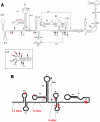
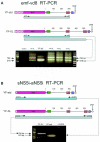
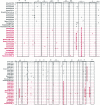
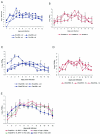
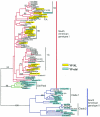
Similar articles
-
Genetic relationships and evolution of genotypes of yellow fever virus and other members of the yellow fever virus group within the Flavivirus genus based on the 3' noncoding region.J Virol. 2004 Sep;78(18):9652-65. doi: 10.1128/JVI.78.18.9652-9665.2004. J Virol. 2004. PMID: 15331698 Free PMC article.
-
Detection of a new yellow fever virus lineage within the South American genotype I in Brazil.J Med Virol. 2010 Jan;82(1):175-85. doi: 10.1002/jmv.21606. J Med Virol. 2010. PMID: 19950229
-
Persistence of Yellow fever virus outside the Amazon Basin, causing epidemics in Southeast Brazil, from 2016 to 2018.PLoS Negl Trop Dis. 2018 Jun 4;12(6):e0006538. doi: 10.1371/journal.pntd.0006538. eCollection 2018 Jun. PLoS Negl Trop Dis. 2018. PMID: 29864115 Free PMC article.
-
Yellow fever: a disease that has yet to be conquered.Annu Rev Entomol. 2007;52:209-29. doi: 10.1146/annurev.ento.52.110405.091454. Annu Rev Entomol. 2007. PMID: 16913829 Review.
-
The enigma of yellow fever in East Africa.Rev Med Virol. 2008 Sep-Oct;18(5):331-46. doi: 10.1002/rmv.584. Rev Med Virol. 2008. PMID: 18615782 Review.
Cited by
-
An RNA pseudoknot is required for production of yellow fever virus subgenomic RNA by the host nuclease XRN1.J Virol. 2010 Nov;84(21):11395-406. doi: 10.1128/JVI.01047-10. Epub 2010 Aug 25. J Virol. 2010. PMID: 20739539 Free PMC article.
-
What Does the Future Hold for Yellow Fever Virus? (I).Genes (Basel). 2018 Jun 8;9(6):291. doi: 10.3390/genes9060291. Genes (Basel). 2018. PMID: 29890711 Free PMC article. Review.
-
Molecular epidemiology of yellow fever in Bolivia from 1999 to 2008.Vector Borne Zoonotic Dis. 2011 Mar;11(3):277-84. doi: 10.1089/vbz.2010.0017. Epub 2010 Oct 6. Vector Borne Zoonotic Dis. 2011. PMID: 20925524 Free PMC article.
-
Functional Information Stored in the Conserved Structural RNA Domains of Flavivirus Genomes.Front Microbiol. 2017 Apr 3;8:546. doi: 10.3389/fmicb.2017.00546. eCollection 2017. Front Microbiol. 2017. PMID: 28421048 Free PMC article. Review.
-
What Does the Future Hold for Yellow Fever Virus? (II).Genes (Basel). 2018 Aug 21;9(9):425. doi: 10.3390/genes9090425. Genes (Basel). 2018. PMID: 30134625 Free PMC article. Review.
References
-
- Bredenbeek, P. J., E. A. Kooi, and B. D. Lindenbach. 2003. A stable full-length yellow fever virus cDNA clone and the role of conserved RNA elements in flavivirus replication. J. Gen. Virol. 84:1261-1268. - PubMed
-
- Bryant, J. E., and A. D. T. Barrett. 2003. Comparative phylogenies of yellow fever isolates from Peru and Brazil. FEMS Immunol. Med. Microbiol. 39:103-118. - PubMed
-
- Charlier, N., P. Leyssen, C. W. Pleij, P. Lemey, F. Billoir, K. Van Laethem, A. M. Vandamme, E. De Clercq, X. de Lamballerie, and J. Neyts. 2002. Complete genome sequence of Montana Myotis leukoencephalitis virus, phylogenetic analysis and comparative study of the 3′ untranslated region of flaviviruses with no known vector. J. Gen. Virol. 83:1875-1885. - PubMed
Publication types
MeSH terms
Substances
Grants and funding
LinkOut - more resources
Full Text Sources
Molecular Biology Databases
Research Materials

